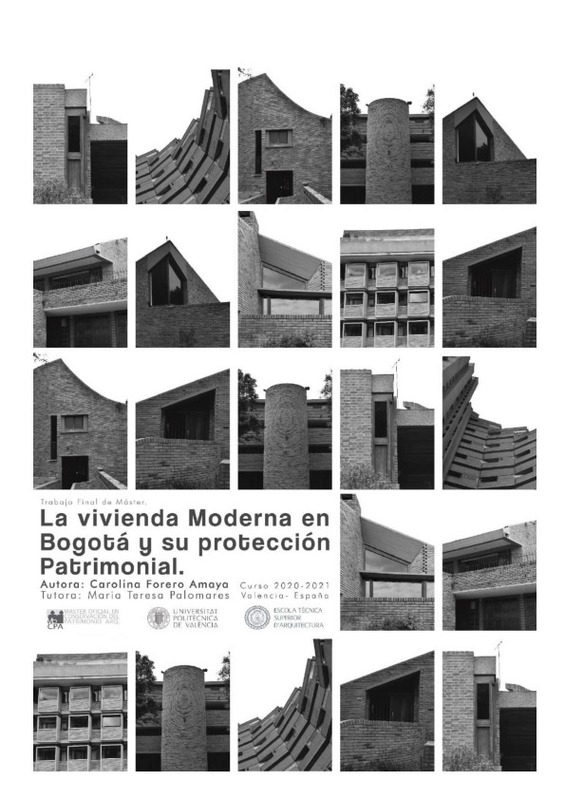|
Resumen:
|
[ES] Los atributos y la evolución de la vivienda se han remontado a constantes transformaciones a lo largo de la historia, en busca de responder a demandas sociales, culturales, del lugar y de las personas que la habitan. ...[+]
[ES] Los atributos y la evolución de la vivienda se han remontado a constantes transformaciones a lo largo de la historia, en busca de responder a demandas sociales, culturales, del lugar y de las personas que la habitan. Estos cambios se ven también definidos por la época en la que se diseñan, los materiales que la definen y las características del arquitecto.
Esta investigación toma como objeto de estudio doce viviendas modernas declaradas patrimonio colombiano. Las viviendas han sido clasificadas en tres tipos distintos, unifamiliares y multifamiliares, que a su vez se dividen en bloques y torres. Por su representatividad, singularidad, valor y autor se han destacado en la arquitectura moderna en Colombia.
Se pretende establecer relaciones de diseño entre las diferentes viviendas por medio de la identificación de sus características técnicas, históricas, funcionales y estéticas para identificar sus valores patrimoniales, como base de su catalogación en bienes de interés cultural.
De las doce viviendas estudiadas, este estudio se centrará en el análisis patológico de siete de ellas, centrado en la característica en común de haber sido construidas en ladrillo, un material representativo y autóctono colombiano que identifica una gran parte de la arquitectura moderna en Bogotá, y de Colombia en particular.
[-]
[EN] The attributes and evolution of the home have undergone constant transformations throughout history answering the social, cultural and location based requisites as well as those of the people that inhabit them. These ...[+]
[EN] The attributes and evolution of the home have undergone constant transformations throughout history answering the social, cultural and location based requisites as well as those of the people that inhabit them. These changes have been defined by the period in which they were designed, the materials available and the characteristics or style of the architect.
The purpose of this investigation is to study twelve modern dwellings declared as Colombian heritage that have been categorised into three different types, namely single-family dwellings and multi-family dwellings such as blocks of flats and towers that, for their representativeness, uniqueness value and author form the backdrop of modern Colombian architecture.
I aim to highlight the relationship between the designs of each housing project by means of classifying their characteristics such as location, technique, history, function and aesthetics in order to identify their respective patrimonial values, which have led them to be recognised today as assets of cultural interest.
Of the twelve aforementioned dwellings, this study will focus specifically around the in-depth analysis of seven of them; the common feature having been built in brick, an autochthonous and representative material that today defines a large part of modern architecture throughout the country.
[-]
[VA] Els atributs i l'evolució de l'habitatge s'han remuntat a constants transformacions al llarg de la història, a la recerca de respondre a demandes socials, culturals, del lloc i de les persones que l'habiten. Aquests ...[+]
[VA] Els atributs i l'evolució de l'habitatge s'han remuntat a constants transformacions al llarg de la història, a la recerca de respondre a demandes socials, culturals, del lloc i de les persones que l'habiten. Aquests canvis es veuen també definits per l'època en la qual es dissenyen, els materials que la defineixen i les característiques de l'arquitecte.Aquesta investigació pren com a objecte d'estudi dotze habitatges moderns declarades patrimoni colombià. Els habitatges han sigut classificades en tres tipus diferents, unifamiliars i multifamiliars, que al seu torn es divideixen en blocs i torres. Per la seua representativitat, singularitat, valor i autor s'han destacat en l'arquitectura moderna a Colòmbia.Es pretén establir relacions de disseny entre els diferents habitatges per mitjà de la identificació de les seues característiques tècniques, històriques, funcionals i estètiques per a identificar els seus valors patrimonials, com a base de la seua catalogació en béns d'interés cultural.Dels dotze habitatges estudiades, aquest estudi se centrarà en l'anàlisi patològica deset d'elles, centrat en la característica comuna d'haver sigut construïdes en rajola, un material representatiu i autòcton colombià que identifica una part de l'arquitectura moderna a Bogotà, i de Colòmbia en particular.
[-]
|







